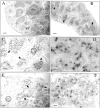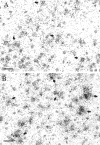T-lymphocyte activation increases hypothalamic and amygdaloid expression of CRH mRNA and emotional reactivity to novelty
- PMID: 10341253
- PMCID: PMC6782622
- DOI: 10.1523/JNEUROSCI.19-11-04533.1999
T-lymphocyte activation increases hypothalamic and amygdaloid expression of CRH mRNA and emotional reactivity to novelty
Abstract
Stimulation of T-cells with staphylococcal enterotoxin B (SEB) significantly elevates interleukin-2 (IL-2) and contemporaneous activation of the hypothalamic-pituitary-adrenal (HPA) axis and c-fos in the paraventricular nucleus (PVN) of BALB/cByJ mice. Such neural signaling may promote cognitive and emotional adaptation before or during infectious illness. Because corticotropin-releasing hormone (CRH) is an anxiogenic neuropeptide that may mediate the stressor-like effects of immunological stimuli, we measured neuronal CRH mRNA alterations in mice challenged with SEB. Increased CRH mRNA levels were observed in the PVN and central nucleus of the amygdala (ceA) 4-6 hr after SEB administration. This was associated with plasma ACTH increases, which could be abrogated by the systemic administration of anti-CRH antiserum. Additional experiments did not support a role for IL-2 or prostaglandin synthesis in activating the HPA axis. Behavioral experiments testing for conditioned taste aversion did not confirm that SEB challenge promotes malaise. However, consistent with the notion that central CRH alterations induced by SEB may affect emotionality (e.g., fear), SEB challenge augmented appetitive neophobia in a context-dependent manner, being marked in a novel and stressful environment. It is hypothesized that immunological stimuli generate a cascade of events that solicit integrative neural processes involved in emotional behavior. As such, these data support the contention that affective illness may be influenced by immunological processes and the production of cytokines and are consistent with other evidence demonstrating that autoimmune reactivity is associated with enhanced emotionality.
Figures






Similar articles
-
Psychological stress increased corticotropin-releasing hormone mRNA and content in the central nucleus of the amygdala but not in the hypothalamic paraventricular nucleus in the rat.Brain Res. 1999 Dec 11;850(1-2):136-43. doi: 10.1016/s0006-8993(99)02114-9. Brain Res. 1999. PMID: 10629757
-
Acute glucocorticoid pretreatment suppresses stress-induced hypothalamic-pituitary-adrenal axis hormone secretion and expression of corticotropin-releasing hormone hnRNA but does not affect c-fos mRNA or fos protein expression in the paraventricular nucleus of the hypothalamus.J Neuroendocrinol. 2003 Nov;15(11):1075-83. doi: 10.1046/j.1365-2826.2003.01100.x. J Neuroendocrinol. 2003. PMID: 14622438
-
Brainstem hemisection decreases corticotropin-releasing hormone mRNA in the paraventricular nucleus but not in the central amygdaloid nucleus.J Neuroendocrinol. 1996 Jul;8(7):543-51. doi: 10.1046/j.1365-2826.1996.04888.x. J Neuroendocrinol. 1996. PMID: 8843023
-
Hypothalamic-pituitary-adrenal activation by the bacterial superantigen staphylococcal enterotoxin B: role of macrophages and T cells.Neuroendocrinology. 1997 Jan;65(1):18-28. doi: 10.1159/000127161. Neuroendocrinology. 1997. PMID: 9032771
-
The stress system in the human brain in depression and neurodegeneration.Ageing Res Rev. 2005 May;4(2):141-94. doi: 10.1016/j.arr.2005.03.003. Ageing Res Rev. 2005. PMID: 15996533 Review.
Cited by
-
Role of the kynurenine pathway and the endocannabinoid system as modulators of inflammation and personality traits.Psychoneuroendocrinology. 2019 Dec;110:104434. doi: 10.1016/j.psyneuen.2019.104434. Epub 2019 Sep 5. Psychoneuroendocrinology. 2019. PMID: 31525567 Free PMC article.
-
How T-cell-dependent and -independent challenges access the brain: vascular and neural responses to bacterial lipopolysaccharide and staphylococcal enterotoxin B.Brain Behav Immun. 2009 Oct;23(7):1038-52. doi: 10.1016/j.bbi.2009.06.004. Epub 2009 Jun 12. Brain Behav Immun. 2009. PMID: 19524662 Free PMC article.
-
Neuronal, endocrine, and anorexic responses to the T-cell superantigen staphylococcal enterotoxin A: dependence on tumor necrosis factor-alpha.J Neurosci. 2005 Jun 1;25(22):5314-22. doi: 10.1523/JNEUROSCI.0687-05.2005. J Neurosci. 2005. PMID: 15930379 Free PMC article.
-
Hypothalamic integration of immune function and metabolism.Prog Brain Res. 2006;153:367-405. doi: 10.1016/S0079-6123(06)53022-5. Prog Brain Res. 2006. PMID: 16876587 Free PMC article. Review.
-
Effects of acute and repeated administration of Staphylococcal enterotoxin A on Morris water maze learning, corticosterone and hippocampal IL-1β and TNFα.Brain Behav Immun. 2011 Jul;25(5):938-46. doi: 10.1016/j.bbi.2010.10.005. Epub 2010 Oct 12. Brain Behav Immun. 2011. PMID: 20946950 Free PMC article.
References
-
- Anisman H, Zacharko RM (1992) Depression as a consequence of inadequate neurochemical adaptation in response to stressors. Br J Psychiatry [Suppl] 36–43. - PubMed
-
- Anisman H, Zalcman S, Zacharko RM. The impact of stressors on immune and central neurotransmitter activity: bidirectional communication. Rev Neurosci. 1993;4:147–180. - PubMed
-
- Anisman H, Kokkinidis L, Merali Z. Interleukin-2 decreases accumbal dopamine efflux and responding for rewarding lateral hypothalamic stimulation. Brain Res. 1996;731:1–11. - PubMed
-
- Bamberger CM, Wald M, Bamberger AM, Ergun S, Beil FU, Schulte HM. Human lymphocytes produce urocortin, but not corticotropin-releasing hormone. J Clin Endocrinol Metab. 1998;83:708–711. - PubMed
Publication types
MeSH terms
Substances
Grants and funding
LinkOut - more resources
Full Text Sources
Research Materials
